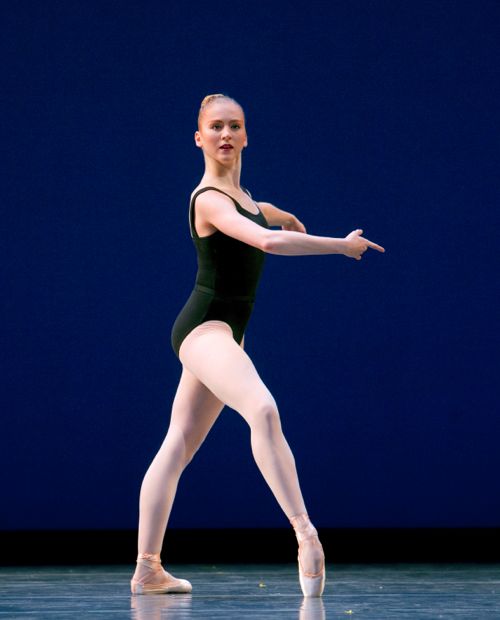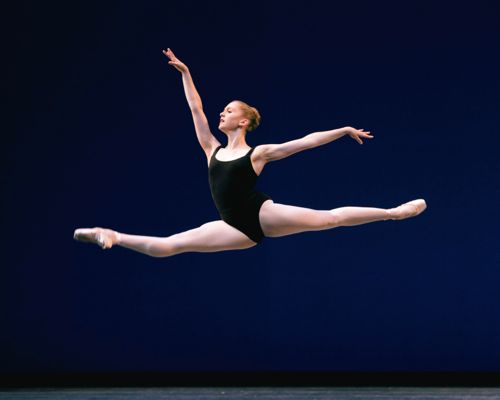Works & Process: Pacific Northwest Ballet / Guggenheim Museum, NYC / September 9 & 10, 2012
The dance programs in the Guggenheim Museum’s Works & Process series, each a 90-minute presentation that shunts between dancing and talking, are viewed, live, two or three times, in the museum’s tiny theater, and telecast simultaneously from sea to shining sea. Most often, these lecture-dems serve as preludes to a run in New York; in harsher words the company that’s featured is shilling for its upcoming shows. The tough practicality of this arrangement is softened by the charm of the programs’ rehearsal-room immediacy—the dancers wear practice clothes and their music comes from a single piano. The audience, of course, adores going “behind the scenes.”
 Pacific Northwest Ballet’s Carla Körbes, dancing Balanchine
Pacific Northwest Ballet’s Carla Körbes, dancing Balanchine
Photo: Angela Sterling
September 9 and 10 featured the Seattle-based Pacific Northwest Ballet, and all the talking was done by its artistic director, Peter Boal, formerly a principal dancer with the New York City Ballet and a model of pure classicism with a prominent penchant for exactitude. He had a clear theme, which was the way in which, over the years, George Balanchine—essentially City Ballet’s raison d’être—made changes in his works. These different readings of the master’s choreography were illustrated by the dancers’ executing excerpts from Apollo (created in 1928), The Four Temperaments (1946), Agon (1957), and Tchaikovsky Pas de Deux (1960). Thanks to Boal’s predecessor, Francia Russell, Balanchine’s ballets have been central to PNB’s repertory since Boal was a mere (but, even then, marvelous) child at the School of American Ballet.
It required keen and experienced eyes to “get” everything Boal wanted the spectators to see. What was memorable about the occasion was not the detailed analysis, though, but the brilliance and daring of the dancers.
The Guggenheim’s small theater has a stage of Lilliputian dimensions. This cruelly confined space was not only hampering but dangerous as well. Every time a woman was lifted high over her partner’s head, her skull ran the risk of smashing into the overhead lights. A series of swiftly whirling turns seemed to court disaster yet, miraculously, never came to grief. The dancers performed with elated zest—boldly and bravely, adamantly refusing to be discouraged by boundaries.
 Körbes, dancing Balanchine
Körbes, dancing Balanchine
Photo: Angela Sterling
The six dancers involved were indeed good, if nowhere near as stellar as the artists New Yorkers see regularly at City Ballet and American Ballet Theatre. But neither are they what used to be called (damning with a label) “regional”—good enough for second-level troupes but not for the big time. PNB’s men are especially distinguished by an air of having thought long and carefully about their roles. Still, Carla Körbes was unquestionably the most important among the performers. She’s a born ballerina, world-class, who has an unfortunately shaky career behind her. Just now, with PNB, she seems, finally, to have come into her own, fusing superb technique with potent personality and an accompanying delight. Ironically, she was first discovered by Boal in her native Brazil, at the age of 14.
PNB will perform at the New York City Center February 13-16, 2013, offering an all-Balanchine program alternating with Jean-Christophe Maillot’s Roméo et Juliette.
© 2012 Tobi Tobias




Watched it online. Learned some things.
I was out of town and couldn’t attend the Guggenheim showing. However I have a ticket for PNB’s all-Balanchine program at City Center. I’m really looking forward to it.
I really think you are going overboard by hypothesizing that PNB is “shilling” for its upcoming shows. The company has participated in the Guggenheim’s Works & Process series previously, to much acclaim. Though I will never forgive Boal for dismissing Ariana Lallone from PNB before normal retirement age, he makes an articulate “M.C.” for these enlightening demonstrations.
I feel extra fortunate — when the company presented this lec-dem here in Seattle last year, Francia Russell shared the MC job with Peter Boal, adding another layer to the “I was there” commentary. It is always fascinating to hear her speak about her experiences with this repertory, but particularly in this context, where they each reflected on the choices that a stager makes, and what elements came into play as Balanchine made changes in his work.